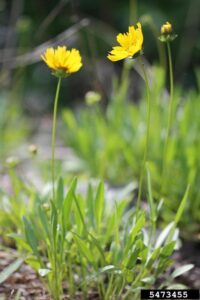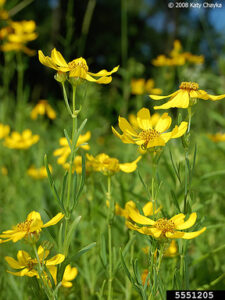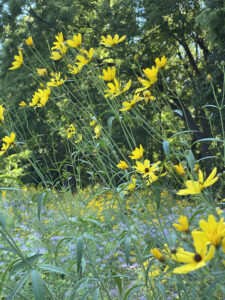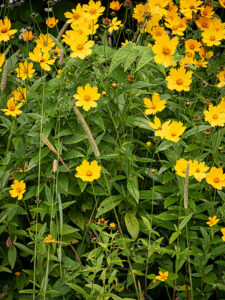NATIVES TO KNOW: Coreopsis
By Joyce Tuharsky, WORC Member
Coreopsis will light up your garden with cheerful, daisy-like flowers that are prized for their long blooming period. These native plants are sun-loving, drought and heat tolerant, low maintenance, deer resistant, happy to grow in relatively poor soil, and make good cut flowers. Bees and butterflies love its nectar; small birds such as goldfinches love its seeds. Beekeepers consider all Coreopsis species to be good honey sources.
Despite all that, I must admit, I get frustrated with Coreopsis at times…. This plant seems to move to places I did not intend. OR disappears all together! …. What is going on? Is something eating it? I wanted to find out, which is why I choose Coreopsis to research for this article.
What I learned is this: Although considered a perennial, Coreopsis does not tend to live more than 3 to 5 years, explaining why it sometimes disappears. But it does readily reseed, perhaps explaining why it turns up in places I do not intend. Some answers: Not reliably perennial, but readily reseed-able.
Coreopsis are members of the Aster family (Asteraceae), also commonly called “tickseed” due to the unusual shape of its seed capsules. It is easy to grow and resilient once established. It prefers full sun (6–8 hours/day) and well drained soils. Stony soil or soil low in nutrients is ok, but avoid clay; this plant does not like soggy roots. If you grow Coreopsis from seed, do not cover the seeds; they need light to germinate. Coreopsis is great for gravel/rock gardens, borders, prairies, meadows and can be grown in containers.
Coreopsis will grow in part shade, but will not bloom as prolifically. They typically start blooming in early summer, then flower on and off until frost. To encourage reblooming, snip off spent flower heads. Leave some seedheads at the end of the season for birds to enjoy… and so the plant will reseed itself.
In recent years, breeders have introduced several hybrids of Coreopsis with various flower colors: pink, white, peach, red, and even bicolor. However, hybrids usually do not provide nectar or seeds for wildlife. Therefore, be sure to procure plants native to your area. According to the Lady Bird Johnson Wildflower Center, there are at least four Coreopsis species native to Michigan (all yellow):
Lanceleaf (or Sand) Coreopsis, Coreopsis lanceolata —Grows 1–2 ft. high. Native to most of the US and parts of Canada and Mexico. Found on sandy banks, roadsides, grasslands, oak-pine woodlands, and in dunes along Lakes Michigan and Huron. Each flower ray has four lobes, giving the flowers a cheerful whirled look. Easy to grow from seed.
Prairie Coreopsis (or Stiff tickseed), Coreopsis palmata —Grows 2 ft. high. Characterized by numerous narrow leaves that are trilobed, giving them a “bird’s foot” appearance. This species is found only in the five southwestern-most counties of Michigan, in remnant dry to mesic prairie and savanna habitats, much of which has been lost or degraded.
Tall Coreopsis, Coreopsis tripteris —Grows 3–9 ft. high, spreads 2–8 ft. The yellow daisy-like flowers of this Coreopsis have a brown center and rounded smooth tips (reminiscent of Black-eyed Susans). Often grows with Prairie coreopsis (above), but is more widespread throughout southern lower Michigan in prairies and dry open woods. Tolerates clay. Good as a tall plant for rear borders or naturalized in wildflower gardens. Can spread aggressively.
Largeflower tickseed, Coreopsis grandiflora —Grows in clumps 1–2 ft. high and 1–3 wide. Several leafy stems with flowers held high (usually singly) on erect leafless stalks. Flowers are 1½–2 inches wide. Will tolerate clay if well drained. Nice in cottage or rock gardens, prairies and meadows or as mass plantings. Cut back hard in summer if foliage becomes weedy.




